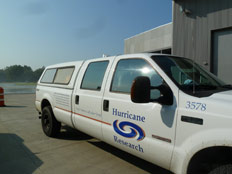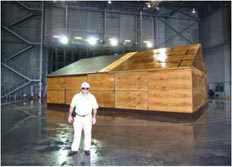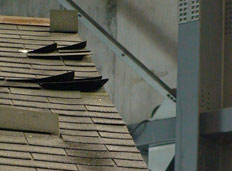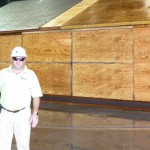
John Minor, CGC, CFM was pleased to be invited on the steering panel of SERRI, a groundbreaking program managed by Oak Ridge National Laboratories for the U.S. Dept of Homeland Security. This project was planned to replicate real world conditions on the effects of shingles on residential structures. The steering committee was made up of many well known names from academia, industry, government and, in my case, roof tops from New York to Miami to the border of Mexico.
Portions of the work were done in the lab at the University of Florida led by Dr. Forrest Masters’s associate professor University of Florida and his lead post graduate student, Craig Dixon. Much of this work was involved in the process of artificially aging the shingles thru the use of ultraviolet radiation in chambers designed specifically for the purpose.

Much of the information was also gathered through the use of residences throughout Florida that, for one reason or another, were available to be dissected by the scientist at UF. Attention in this portion of the study was given to the as built or experienced conditions found in the field. This was to include lifted or non-adhered shingle and those with partial tab sealant loss at the bottom of the shingle manipulated during the course of shingle installation.
The third component of the study was conducted at the IIBHS facility in South Carolina just south of Charlotte www.disastersafety.org. This is where I was able to contribute my portion of the study the most. In this state of the art wind tunnel for lack of a better term shingles were exposed to a close as can be replicated wind and rain similar to that could be expected from a hurricane. The facility is unique in the world in that it has 105 – 310 hp fans that are individually controlled. The wind is then accompanied by streams of water and cyclic action created by huge baffles.

This facility tested a series of hip and gable roof sections from different manufacturers. We utilized both “lifetime” and 25 yr composition shingles that had been aged in place in our testing. Each of these 10 -12 square sample sections were then gone over with a fine tooth comb by the team from the University of Florida and reviewed by me. I was then charged with appraising the appropriate repairs to each of the roof sections including the recommended repairs and the costs segregated by different areas of the country. The locales selected were throughout the southeast from Wilmington N.C. to Miami to Galveston Texas.I am a licensed general contractor in North Carolina, South Carolina and Florida in addition to providing hundreds of appraisals in these locales over the last 20 years. I used Xactimate estimating software in many occasions to determine the hourly rates in these communities while I identified the time. The damage was limited to the sample size inspected and depending on the quantity of scale would have a different factor depending on the size of the roof for a total cost. In addition the repair plan assumed some remaining shingles retained by any individual property for matching purposes or so as not to devalue.
It was a pleasure to work with the other members of the steering committee and I look forward to our future endeavors. If your organization needs a real understanding of property claims please consider calling John Minor at john@teamcomplete.com or find my bio at the Univ.
